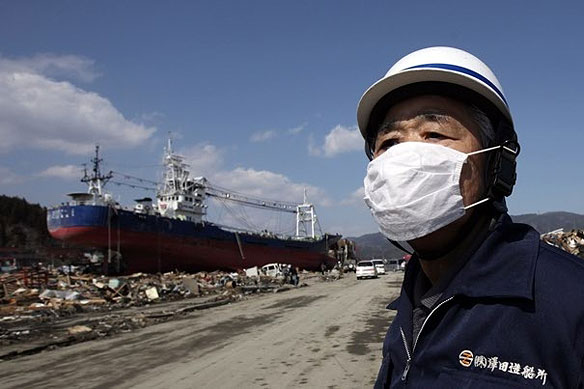By Ken Benson and Hirocko Tabushi
Highly radioactive water is leaking directly into the sea from a damaged pit near a crippled reactor at the Fukushima Daiichi nuclear plant, Japanese safety officials said Saturday, from a crack discovered at a nuclear power plant destabilized by last month’s earthquake and tsunami.
Although higher than normal levels of radiation have been detected in the ocean water near the plant in recent days, the breach discovered Saturday is the first identified direct leak of such high levels of radiation into the sea.
The leak, found at a maintenance pit near the plant’s No. 2 reactor, is a fresh reminder of the dangerous side effects of the strategy to cool the reactors and spent fuel storage pools by pumping hundreds of tons of water a day into them. While much of that water has evaporated, a significant portion has also turned into runoff.
The Japanese authorities have said they have little choice at the moment, since the normal cooling systems at the plant are inoperable and more radiation would be released if the reactors were allowed to melt down fully or if the rods caught fire.
Three workers at the plant, operated by Tokyo Electric Power Company, have been injured by stepping into pools of contaminated water inside one reactor complex.
Workers are racing to drain the excess water, but they have struggled to figure out how to store it. On Saturday, some contaminated water was transferred into a barge to free up space in other tanks on land. A second barge also arrived.
“The more water they add, the more problems they are generating,” said Satoshi Sato, a consultant to the nuclear energy industry and a former engineer with General Electric. “It’s just a matter of time before the leaks into the ocean grow.”
Hidehiko Nishiyama, deputy director general of Japan’s Nuclear and Industrial Safety Agency, said it was possible that water in the pit had leaked from the reactor, although it was also possible that it came from other sources, like leaking pipes. In either case, any leak would be exacerbated by the enormous amounts of water being used to cool the reactor.
Tetsuo Iguchi, a professor in the department of quantum engineering at Nagoya University, said that the leak discovered Saturday raised fears that contaminated water might be seeping out through many more undiscovered sources. He said that unless workers could quickly stop the leaking, Tokyo Electric could be forced to re-evaluate the feed-and-bleed strategy, in which they flood the reactors and fuel ponds with water and then release the steam it creates.
“It is crucial to keep cooling the fuel rods, but on the other hand, these leaks are dangerous,” Mr. Iguchi said. “They can’t let the plant keep leaking high amounts of radiation for much longer,” he said.
Plant workers discovered a crack about eight inches wide in the maintenance pit, which lies between the No. 2 Reactor and the sea and holds cables used to power seawater pumps, Japan’s nuclear regulator said.
The space directly above the water leaking into the sea had a radiation reading of more than 1,000 millisieverts per hour, Mr. Nishiyama said, a level that could be dangerous to humans. Tests of the water within the pit later showed the presence of one million becquerels per liter of iodine 131, a radioactive substance. That level of iodine is 10,000 times what is normal for water at the plant. However, iodine 131 has a half life of about eight days.
Mr. Nishiyama also said that higher than normal levels of radioactive materials were detected about 25 miles south of the Fukushima plant, much farther than had previously been reported.
At the time the leak was discovered, the deep pit was filled with four to eight inches of contaminated water, according to Tokyo Electric. But it was impossible to immediately judge how much water had escaped and over how long a period of time.
Workers had started to try to fill the crack with concrete, Mr. Nishiyama said late Saturday.
Saturday’s announcement of a leak came a day after the United States energy secretary, Steven Chu, said that roughly 70 percent of the core of one reactor at the Fukushima plant had suffered severe damage. The statement was the most specific yet from an American official on how close the plant came to a full meltdown after it was hit by a severe earthquake and massive tsunami on March 11.
Emergency crews poured concrete into the crack Saturday afternoon and again in the evening in a bid to stem the leak, the Yomiuri Shimbun newspaper reported.
The discovery raised the disconcerting possibility that the power company’s decision to drench the reactors with tens of thousands of tons of water in an attempt to submerge the exposed spent fuel rods is having an unintended side effect.
Radiation worries have compounded the misery for people trying to recover from the tsunami.










